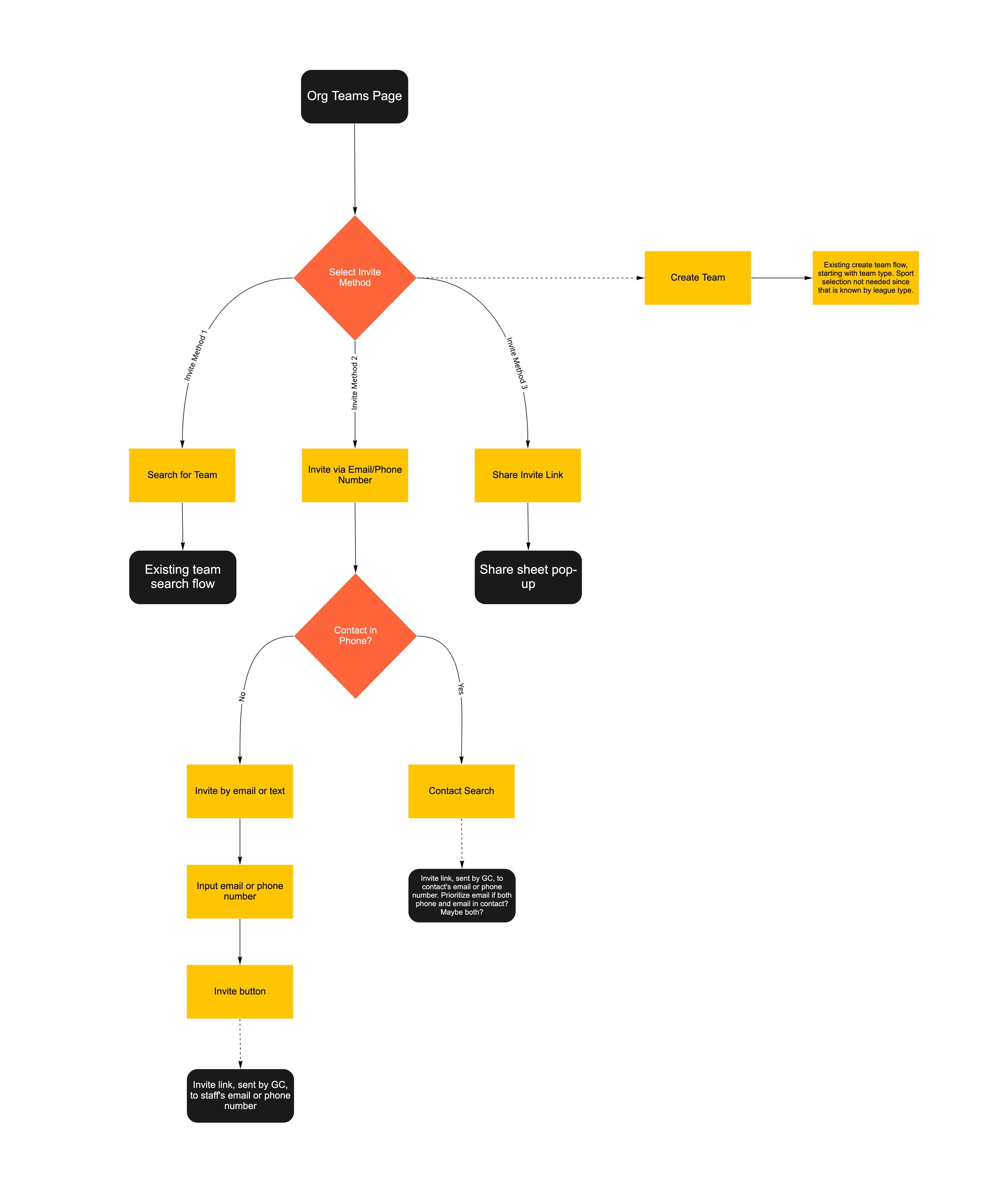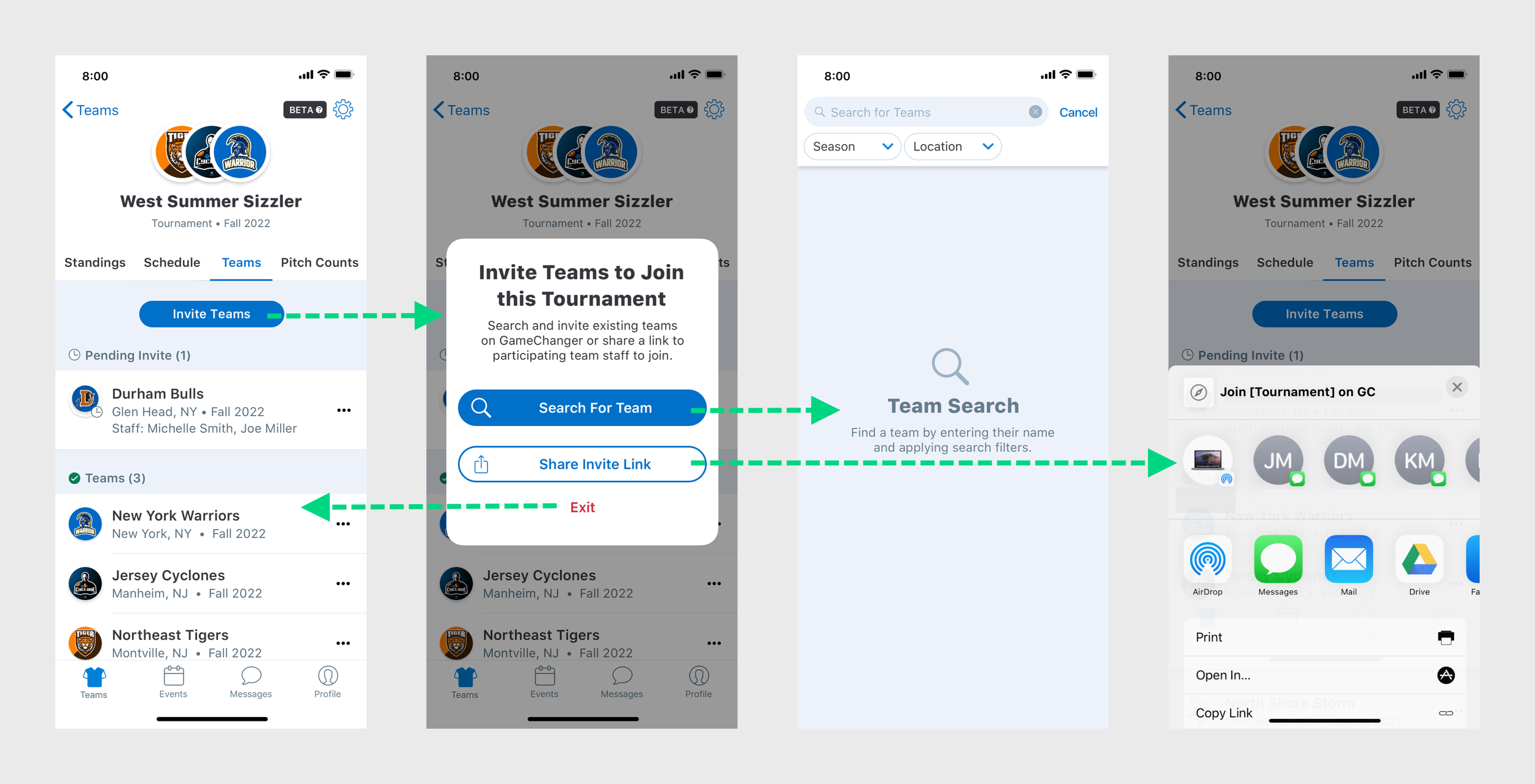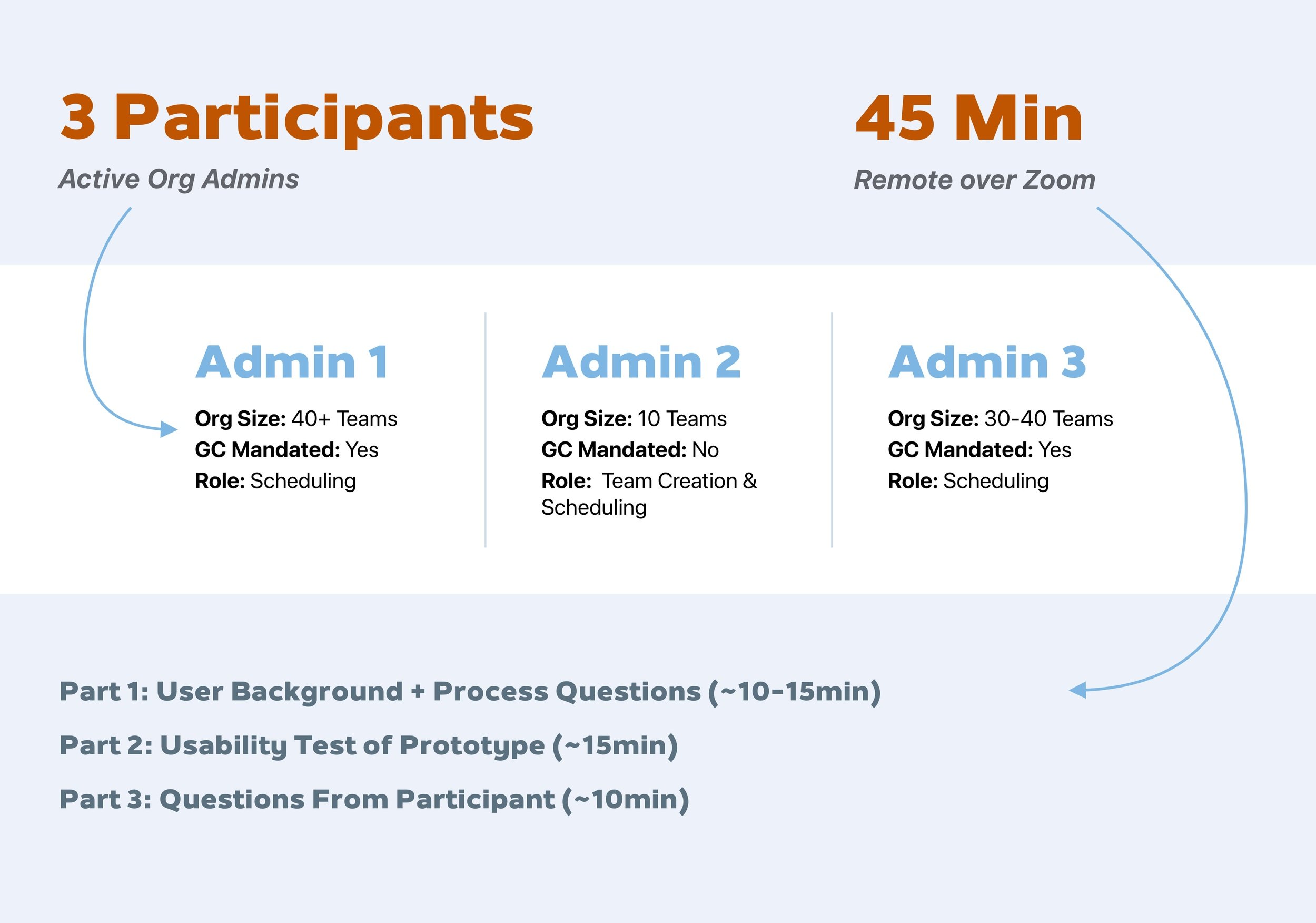GameChanger | Inviting Teams to Join an Org
Reduced organization set-up time by 25%, increased user retention, and reduced churn rate by simplifying the organization invite process.
Year
2022
Role
Product Design Intern
Responsible for all research, design & testing
Platform
Mobile & Web
Project Overview
As GameChanger continues to expand into the youth sports tournament market, we needed to look deeper into our existing “Organization create” flows and consider the needs and use cases of our tournament users. By nature, tournaments have fast turnarounds regarding setup, ie. last-minute team confirmations, registrations, and schedule changes. With our bulk scheduling import completed, we addressed the need for quick game creation, but in order to create games, the Organization must have confirmed teams.
Tournaments can include upwards of fifty to hundreds of teams participating in a 3-day event, and registration can close just 24 hours before games are set to begin. Today, the process of adding and inviting teams takes time and the responsibility falls solely in the hands of the Org Admin to proactively reach out to teams, find teams and send team invites. With today’s existing team invite flow, there is no way for tournaments with tight turnarounds to be fully set up in time come game time.
The Problem
Today, only Organization Admins can invite teams to join their Organization. The process of adding teams to an Organization is tedious - it requires searching and finding the right team, sending an invite to that team, and waiting for that team to accept the invite. Additionally, teams must exist on GameChanger for an Org Admin to send invites and build out their Organization. The current Organization setup process puts additional strain and time on the Admin’s hands that could be better spent elsewhere. With lengthy Org creation time, comes friction and drop-off that winds up in unsuccessful Orgs created.
How might we reduce the time investment for Org admins to add teams while also ensuring team staff are able to seamlessly join regardless of if they are or aren’t already part of GameChanger?
My Role
As the product design intern, I conducted the core research (background, competitive, and user) and designed the mobile-facing experiences for a new method that allows organization managers to invite teams to join their leagues. Additionally, I closely worked with the senior product designer, head of design, and product and engineering managers on my cross-functional team to help inform our project sprint goals and to help determine the platform that we would design for first (e.g. mobile vs web). Additionally, I worked with our team’s software engineers to determine back-end and real-world feasibility. Finally, I jointly conducted user testing with the senior product designer by leading user interview/ prototype testing sessions and presented the findings to our team to inform future designs along with shipping the final screens to our engineers.
Product Goals
Acquire teams into an organization faster and more efficiently, resulting in an increase in successful, active organizations
-
Determine how Admins can get the right teams to join their Organization quickly.
-
Reduce time and friction from the Org admin’s workflow by giving the team staff more control.
-
Understand the opportunities and approaches that we might take to allow for faster Org creation and setup while balancing the engineering needs and requirements of the minimum viable product.
Step 1: Build a Case
GameChanger App Audit
To discover pain points within our existing product, we conducted an in-depth audit of the GameChanger app to document the current process of inviting teams to an org. We performed the audit for two different use cases: as an admin inviting teams to join that they are already staff on and as an admin inviting teams that they are not staff on.
Key Takeaways:
The call to action button to invite teams needs to be made more visually apparent.
The team search logic needs to be overhauled to more clearly show why certain search results are being displayed.
Error handling should be implemented within team search if no teams are found to match the search query.
The difference between “add” a team when you are staff and “invite” when you are not staff is unclear.
Treat inviting any team that has an org admin on it as staff (regardless of which admin is doing the inviting) as “adding” a team, not inviting a team. This will reduce the time and effort it takes to get these teams into the org.
User Feedback From CX Sources
"... I believe that if we were to get everyone underway with the app, they would see the benefits, but getting everyone across the threshold needs to be easier... I attempted to do the most time-consuming part in building the league, setting up teams, entering schedule, and even building rosters before delegating ownership to the appropriate Staff Members... As you know, I can only create the league and my team; then I wait, hoping we don’t fall one team short of making our league work. (I have only 3 opposing teams willing to join if I can get 100% sign up).”
After performing the competitive analysis, I utilized our customer experience (CX) tools to find feedback provided to us directly from our users. This feedback was automatically funneled into Airtable from various sources such as our CX email and Zendesk. Using Airtable, I was able to sort and filter the hundreds of thousands of CX message chains down to feedback specific to our area of focus. I did this by searching for keywords such as “League”, “Org”, “Tournament”, and “Admin” and also sorted by messages that I had pre-categorized as being league/tournament specific.
“Once you create an organization, it asks you to invite teams to join the organization. That means that I need to set up each team also and then join them to the organization. There should be an option where you can create an organization and create teams within that organization each year instead of having to invite the team.”
“Please add functionality to invite a team directly to The league who don’t have a game changer account yet.”
“When I am trying to identify and invite teams to our league, the search function is extremely clunky... Secondly, is there a way to do the opposite? By that I mean, can a team search up our league and ask to be invited?”
“Having to build teams in Team Manager then add them to the organization is time-consuming.”
Step 2: Scout the Competition
Competitive Analysis
An analysis of 6 platforms with league/team management features. Each step in the “invite to join org/team” flows were mapped out with a focus on how league and team administrators get coaches and other staff members to connect with their teams. The various invite methods were individually tested from the perspective of both a league admin and an invited staff member. Design conclusions were then derived from the data.
Design Takeaways
1 - Flexibility to Invite & Join
Provide admins and staff multiple options to both invite and request to join an org.
Examples include tools to directly invite staff to join and a generic link that anyone can use to join.
2 - Reduce Admin Workload
Allow for invited coaches to set up their teams during onboarding, rather than having the admin set up the team and then inviting the coach to join.
Provide a bulk roster importer to assist with this process.
Step 3: Make Things…
Invite Methods Explored
Based on the findings of the competitive analysis and informed by our dive into CX user feedback and our sketching exercise, we settled on exploring designs for these invite methods.
Team Search
Share Invite Link
Send an Email/Text
Share Code
Create Team
Brainstorming/Sketching/Ideation
After presenting my research to our cross-functional team at a project kickoff meeting, we conducted a brainstorming session using the Crazy 8s design sprint method. Four team members were involved incorporating stakeholders from all facets of the cross-functional team: The director of project management, one senior software engineer, one senior product designer, and myself (the product design intern).
After conducting the session, we discussed our sketches together. Some of the key takeaways from this session were:
User Flow Mapping
To start the process of working on wireframes and prototypes, I mapped out possible user flows, from the perspective of an org admin. I used these maps to ensure that we were considering all possible use cases and to visualize the underlying information architecture. These maps also helped the team to understand what flows and tech were already built out and which needed to be created specifically for this project.
Invite flow with four methods
Invite flow using a Share Code
The existing method of inviting a team to an Org. How can we improve on this?
Have GC send a preformatted email or text message to staff members that the admin inputs.
Allow an admin to send a deeplink to anyone using a Share Sheet.
Allow teams to find an Org by use of a share code disseminated via the Org admin.
Allow admins to create a placeholder team for scheduling purposes, in case some teams do not sign up for GC.
-
A deeplink would allow us to more easily redirect our users to download the app in the event that the invite flow would be completed entirely on mobile.
-
In a tournament situation, there is a use case where there may be a team or two which is either unable or unwilling to sign up for GameChanger. In this situation, tournament bracketing would be rendered useless even if only one team is missing. For this use case, we need to allow tournament admins the ability to create a placeholder team.
-
We had previously built a CSV importer for adding org schedules. Could we use this same tech to bulk import teams? Would our users find this valuable?
Design Exploration
Teams Page Button Layouts
Invite Method Screens
The end goal of our design exploration was to produce a testable prototype that balanced usability and features with engineering and time resources. We started by designing for all of the invite methods discussed above and then through feedback from both the design team and engineering team, slowly pared back the features to come up with the best combination of usability and simplicity for our users.
Final Prototype For Testing
Step 4: Talk to Other Humans (Our Users)
User Testing Goals
Understand how an Org admin would go about inviting teams to their Organization and validate if they’re able to do so through our flows
1.
Understand if the inviting functionality would perform better on desktop or on mobile from an accessibility and feasibility standpoint
2.
User Interviews
User Summaries
Design Recommendations
Share Link
Prioritize the Share Link invite method over the Team Search method. Participants were frustrated with the bugs and amount of dead and inactive teams associated with the team search. They overwhelmingly expressed that using a shareable link would be their method of choice. Admin 1 remarked that it would save an hour or more worth of time.
Minimize Investment for Team Staff to Join
There is a learning curve and time commitment required for team staff to sign up for GC. When invited team staff who are not already on GC accept an invite, keep the time investment to the absolute bare minimum to help encourage buy-in and adoption.
Stay Mobile (For Now)
Use mobile as the primary platform for admin side invite tools. The Share Sheet is extremely important as each admin uses a different method of communication with their org. In addition, none of the participants expressed that the task of inputting contact information was complicated or considered a “bulk” or “batch” task, which is the main motivation for using a desktop. Participants did express however that GC on web is currently lacking when compared to mobile
Methods Should be Discoverable
The investment to learn how to use GC is already considered high by many users. In addition, inviting teams to an org is an absolute requirement for league admins on GC. The invite methods should be readily apparent and easily found as opposed to hidden away within the interface. Consider removing the modal and testing a design displaying the invite methods directly on the teams page to increase discoverability even further.
Next Steps
Develop a web-focused version of this flow and test with users to determine which solution is ideal for our users.
1.
Develop an MVP based on the user interview data and provide the design specifications to the engineers.
2.
3.
Usability test the MVP and continue to iterate on prototype designs.
Learnings
Involve direct user feedback via user interviews and email questionnaires (in addition to the indirect feedback gathered by CX methods) at the beginning of the design process.
Survey users prior to conducting targeted user testing to gather broader data. This would reduce the large amount of guesswork we had to do when designing the prototype iterations.
Validate high-level design decisions by testing with low-fidelity wireframes earlier in the process.














